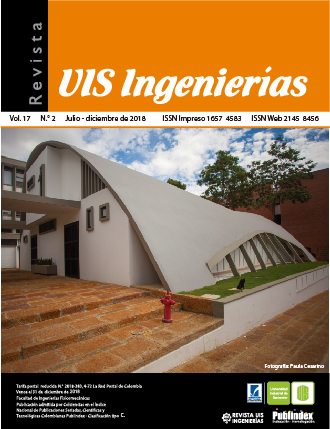Effect of rounding radius of the carina on the development of the flow within a synthetic model of lower human airways
Published 2018-06-12
Keywords
- Biofluids,
- carina,
- computational fluid dynamics
How to Cite
Abstract
The effect of the rounding radius of the Carina, during inhalation stage for the respiration process, was explored numerically through computational simulations based on a synthetic model of human airways. The geometries were parameterized in terms of the dimensionless curvature of carina. In the present study, two Reynolds numbers were explored in laminar flow regime. The results show that the variation of this physiological parameter affects the magnitude and distribution of the wall shear stresses, as well as the behavior of vortical structures observed in the secondary flow. This parameter also affects, although to a lesser extent, the pressure drops across the branches. The effects produced by the variation of this curvature on physiological aspects of the breathing process are analyzed. Finally, a brief discussion about the advantages of the use of CFD simulation techniques for the study of phenomena associated to biofluids is presented.
Downloads
References
Lee, D., Park, S. S., Ban-Weiss, G. A., Fanucchi, M. V., Plopper, C. G. and Wexler, A. S. “Bifurcation model for characterization of pulmonary architecture”, The Anatomical Record, vol. 291, no 4, p. 379-389, 2008.
Kang, M. Y., Hwang, J. and Lee, J. W. “Effect of geometric variations on pressure loss for a model bifurcation of the human lung airway”, Journal of biomechanics, vol. 44, no 6, p. 1196-1199, 2011.
Schroter, R. C. and Sudlow, M. F. “Flow patterns in models of the human bronchial airways”, Respiration physiology, vol. 7, no 3, p. 341-355, 1969.
Liu, Y., So, R. M. C. and Zhang, C. H. “Modeling the bifurcating flow in a human lung airway”, Journal of biomechanics, vol. 35, no 4, p. 465-473, 2002.
Comer, J. K., Kleinstreuer, C. and Zhang, Z. “Flow structures and particle deposition patterns in double-bifurcation airway models. Part 1. Air flow fields”. Journal of Fluid Mechanics, vol. 435, p. 25-54, 2001.
Chu, C. P. W. and Chen, P. P. “Tracheobronchial injury secondary to blunt chest trauma: diagnosis and management”. Anaesthesia and intensive care, vol. 30, no 2, p. 145, 2002.
Van Ertbruggen, C., Hirsch, C. and Paiva, M. “Anatomically based three-dimensional model of airways to simulate flow and particle transport using computational fluid dynamics”, Journal of applied physiology, vol. 98, no 3, p. 970-980, 2005.
Haskin, P. H. and Goodman, L. R. “Normal tracheal bifurcation angle: a reassessment”. American Journal of Roentgenology, vol. 139, no 5, p. 879-882, 1982.
Sahni, D., Batra, Y. K. and Rajeev, S. “Anatomical dimensions of trachea, main bronchi, subcarinal and bronchial angles in fetuses measured ex vivo”. Pediatric Anesthesia, vol. 18, no 11, p. 1029-1034, 2008.
D'Souza, A., Ankolekar, V. H., Das, A., Padmashali, S., D’Souza, A. S. and Mamatha, H. “Determination of inter-bronchial and subcarinal angles in fetuses of different gestational age and their clinical implication”. Muller Journal of Medical Sciences and Research, vol. 6, no 2, p. 129-132, 2015.
West, J. B. “Respiratory physiology: the essentials”. Lippincott Williams & Wilkins, MLA. 2012
Weibel, E. R. “Geometric and dimensional airway models of conductive, transitory and respiratory zones of the human lung”. Morphometry of the human lung. p. 136-142, 1963.
Horsfield, K., Dart, G., Olson, D. E., Filley, G. F.and Cumming, G. “Models of the human bronchial tree”. Journal of applied physiology, vol. 31, no 2, p. 207-217, 1971.
Zhao, Y. and Lieber, B. B. “Steady inspiratory flow in a model symmetric bifurcation”, Transactions of the ASME-K-Journal of Biomechanical Engineering, vol. 116, no 4, p. 488-496, 1994.
Calay, R. K., Kurujareon, J. and Holdo, A. E. “Numerical simulation of respiratory flow patterns within human lung”, Respiratory physiology & neurobiology, vol. 130, no 2, p. 201-221, 2002.
Yu, G., Zhang, Z. and Lessmann, R. “Computer simulation of the flow field and particle deposition by diffusion in a 3-D human airway bifurcation”, Aerosol Science and Technology, vol. 25, no 3, p. 338-352, 1996.
Xia, G., Tawhai, M. H., Hoffman, E. A. and Lin, C. L. “Airway wall stiffening increases peak wall shear stress: a fluid–structure interaction study in rigid and compliant airways”, Annals of biomedical engineering, vol. 38, no 5, p. 1836-1853, 2010.
Dailey, H. L., Yalcin, H. C. and Ghadiali, S. N. “Fluid-structure modeling of flow-induced alveolar epithelial cell deformation”, Computers & structures, vol. 85, no 11, p. 1066-1071, 2007.
Sidhaye, V. K., Schweitzer, K. S., Caterina, M. J., Shimoda, L. and King, L. S. “Shear stress regulates aquaporin-5 and airway epithelial barrier function”, Proceedings of the National Academy of Sciences, vol. 105, no 9, p. 3345-3350, 2008.
Pedley, T. J., Schroter, R. C. and Sudlow, M. F. “The prediction of pressure drop and variation of resistance within the human bronchial airways”, Respiration physiology, vol. 9, no 3, p. 387-405, 1970.

